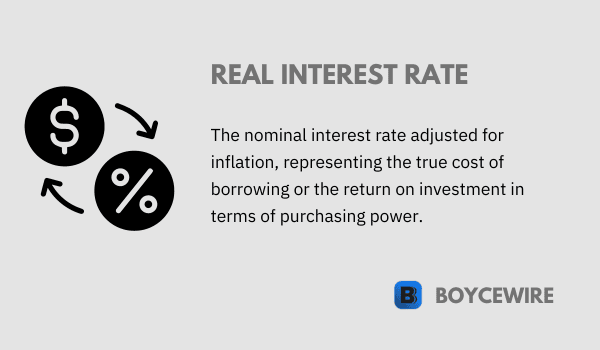Real Interest Rate: How to Calculate, Effects & Examples

What is Real Interest Rate?
Interest rates play an integral role in the global economic landscape, influencing everything from individual savings and loans to government policy and corporate investment. However, the “headline” or nominal interest rate often reported in the media doesn’t tell the full story. It’s the real interest rate – the interest rate adjusted for inflation – that truly impacts economic decisions. Understanding this concept is vital because it reflects the actual purchasing power derived from lending or saving money.
Real interest rates provide a more accurate measure of profitability for savers and cost for borrowers, giving a clearer picture of the financial market conditions. They also act as an important tool for central banks when formulating monetary policy.
Key Points
- Real interest rates represent the nominal interest rate adjusted for inflation, providing a more accurate measure of the true return on an investment.
- A higher real interest rate makes borrowing more expensive and can discourage borrowing, while a lower rate can incentivize borrowing and stimulate economic activity.
- Real interest rates affect savings and investments by influencing the return on savings and the cost of borrowing.
Understanding Real Interest Rates
Real interest rates are a cornerstone of financial and macroeconomic analysis, as they provide a more nuanced view of the cost of borrowing and the return on saving than nominal interest rates alone.
- Difference between Real and Nominal Interest Rates The nominal interest rate is the ‘face value’ interest rate without any adjustment for inflation. It represents the actual percentage increase in money that a lender receives (or a borrower pays) over a given period. However, it does not account for the erosive effects of inflation on purchasing power.
- Real Interest Rates In contrast, the real interest rate is the nominal interest rate adjusted for inflation. It reflects the change in actual purchasing power over the period of the loan or investment. If your money grows at the nominal interest rate, but prices are also rising due to inflation, the amount of goods and services that your money can buy may not increase and could even decrease.
- Factors Influencing Real Interest Rates These rates can be influenced by a variety of factors, including monetary policy, inflation expectations, and global economic conditions.
- Monetary Policy Central banks often use policy tools like the discount rate or open market operations to influence interest rates. These actions can affect both nominal rates and, through their impact on inflation expectations, real rates.
- Inflation Expectations Real interest rates are directly linked to expectations about future inflation. If inflation is expected to rise, lenders will demand higher nominal interest rates to compensate for the loss in purchasing power, pushing up rates.
- Global Economic Conditions Broad economic trends and shocks can impact real rates. For instance, during periods of economic uncertainty, there may be increased demand for safer assets like government bonds, which can push down their yields and thus lower interest rates.
Understanding these factors is crucial for grasping the dynamics of interest rates and their role in the broader economy.
Calculating Real Interest Rate
1. Explanation of the Fisher Equation
Economist Irving Fisher introduced a formula that describes the relationship between real and nominal interest rates and inflation. Known as the Fisher equation, it is expressed as follows:
1 + nominal interest rate = (1 + real interest rate) * (1 + inflation rate)
When the nominal interest rate and the inflation rate are both relatively low (as they often are in practice), the Fisher equation can be approximated as:
Real interest rate ≈ nominal interest rate – inflation rate
2. Step-by-step Calculation of Real Interest Rate
- Identify the nominal interest rate This is the quoted rate before adjusting for inflation.
- Identify the rate of inflation This can be found from government or central bank statistics, usually expressed as a yearly percentage.
- Subtract the rate of inflation from the nominal interest rate This will give you the real interest rate.
3. Example Scenario
Let’s say you have invested in a bond that offers a nominal return of 5% per year. The inflation rate is 2% for the year. Using the approximation form of the Fisher equation, the real interest rate would be:
Real interest rate = nominal interest rate – inflation rate
= 5% – 2%
= 3%
Therefore, once inflation is taken into account, your money’s purchasing power is growing at 3% per year. The real interest rate provides a more accurate measure of your investment’s return in terms of actual purchasing power.
Effects of Real Interest Rate
Understanding the real interest rate is essential as it holds significant influence over a wide range of economic activities. The effects can be seen in personal savings and investments, debt repayments, and broader economic factors like growth and inflation.
1. Effect on Savings and Investments
The real interest rate influences the decision to save or invest. If the rate is high, it means the return on savings or investments, in terms of purchasing power, is high. This situation encourages individuals and businesses to save more or invest in projects offering returns above the real interest rate. On the contrary, if the rate is low or negative, it can deter saving or investing, as the purchasing power of those funds would decline over time.
2. Impact on Debt Repayments
Real interest rates are also important to those borrowing money. A high rate means that the amount of goods and services that must be foregone in the future to repay the loan is greater. Therefore, higher rates can discourage borrowing for consumption or investment. Conversely, low or negative rates can encourage borrowing, as it reduces the real cost of repayment.
3. Influence on Economic Growth and Inflation
On a macroeconomic scale, real interest rates can impact economic growth and inflation. Lower rates often stimulate economic growth by making borrowing cheaper, promoting investment, and encouraging consumer spending. However, such an environment could also potentially lead to higher inflation. Conversely, high rates could slow down the economy, as borrowing costs increase, possibly leading to lower inflation.
Real Interest Rates in Monetary Policy
Real interest rates serve as a crucial tool in the arsenal of central banks when it comes to managing monetary policy. They form a cornerstone of the decision-making process affecting the broader economy. This section will explore how central banks utilize rates in shaping monetary policy and setting policy targets.
1. Role in Central Banks’ Policy Decisions
Central banks, such as the Federal Reserve in the US or the European Central Bank in the Eurozone, often aim to control inflation and promote stable economic growth. To achieve these goals, they manipulate short-term nominal interest rates. However, since the real interest rate affects actual borrowing costs and the incentives for saving and investment, it is the rate that central banks are effectively targeting.
For instance, if a central bank wants to stimulate economic activity during a downturn, it might lower nominal interest rates. Assuming inflation doesn’t change significantly, this would lower real interest rates, making borrowing cheaper and encouraging spending and investment. Conversely, to cool down an overheating economy and curb inflation, a central bank might raise nominal interest rates, thereby increasing interest rates, discouraging borrowing, and slowing down economic activity.
2. Use of Real Interest Rates in Policy Targets
Sometimes, central banks explicitly target a specific real interest rate. This is often the case when they employ inflation targeting, a monetary policy strategy where the central bank aims to keep inflation around a predetermined level. The central bank adjusts the nominal interest rate to meet its inflation target, implicitly targeting a specific interest rate.
To summarize, understanding the role of real interest rates in monetary policy is vital because they represent a central bank’s primary lever for influencing economic activity and inflation. They form a key part of the transmission mechanism through which monetary policy affects the real economy.
Real Interest Rate Trends and Analysis
Real interest rates are not static; they fluctuate over time due to changes in economic conditions, inflation expectations, and monetary policy. Understanding these trends can provide crucial insights into the economic landscape.
1. Historical Trends
Historically, real interest rates have shown substantial variation. For example, during periods of high inflation in the 1970s and early 1980s, interest rates in many countries were significantly negative. Conversely, during the late 1980s and early 1990s, interest rates were relatively high, reflecting tighter monetary policy and lower inflation.
2. Case Studies of Negative Real Interest Rates
Negative real interest rates occur when the rate of inflation surpasses the nominal interest rate. This scenario effectively means that the purchasing power of money decreases even as it accrues nominal interest. Recent examples include the post-2008 period in many advanced economies, where central banks set nominal interest rates to near-zero levels to combat the recession, resulting in negative interest rates due to even modest inflation.
3. Analysis of Real Interest Rates in Different Economies
Real interest rates can differ significantly across countries due to disparities in economic conditions, inflation, and monetary policy. For instance, emerging markets often have higher interest rates compared to advanced economies due to higher inflation expectations and perceived risks.
FAQs
A real interest rate represents the nominal interest rate adjusted for inflation, providing a measure of the true return on an investment after accounting for changes in purchasing power.
The real interest rate can be calculated by subtracting the inflation rate from the nominal interest rate.
The real interest rate helps assess the true cost of borrowing and the potential return on investments, as it accounts for the effects of inflation.
A higher real interest rate makes borrowing more expensive and can discourage borrowing, while a lower rate can incentivize borrowing and stimulate economic activity.
About Paul
Paul Boyce is an economics editor with over 10 years experience in the industry. Currently working as a consultant within the financial services sector, Paul is the CEO and chief editor of BoyceWire. He has written publications for FEE, the Mises Institute, and many others.

Further Reading
 Framing Effect: What it is, Types & Examples - The framing effect is a cognitive bias that impacts our decision making when said if different ways. In other words,…
Framing Effect: What it is, Types & Examples - The framing effect is a cognitive bias that impacts our decision making when said if different ways. In other words,…  Money Laundering - Money laundering is the process of disguising the origins of illegally obtained money to make it appear legitimate.
Money Laundering - Money laundering is the process of disguising the origins of illegally obtained money to make it appear legitimate.  Andrew Yang’s ‘Freedom Dividend’ Doesn’t Add Up - Universal Basic Income: Andrew Yang's 'Freedom Dividend' Doesn't Add Up Even under Yang's optimistic and implausible estimates, he still falls short of…
Andrew Yang’s ‘Freedom Dividend’ Doesn’t Add Up - Universal Basic Income: Andrew Yang's 'Freedom Dividend' Doesn't Add Up Even under Yang's optimistic and implausible estimates, he still falls short of… 
